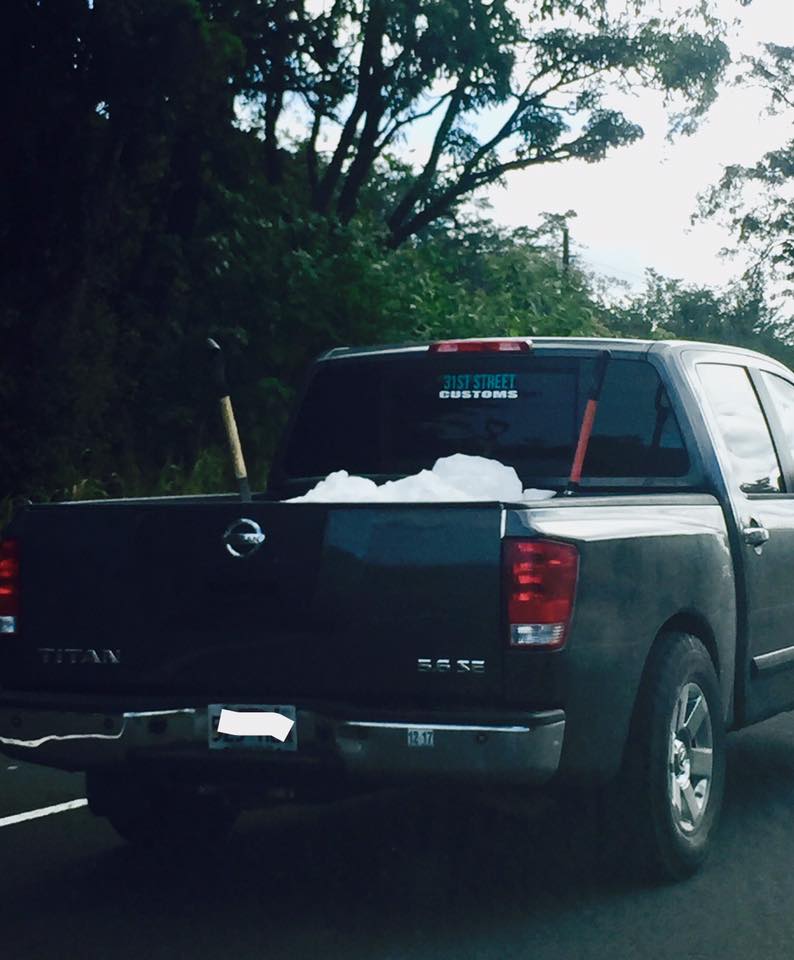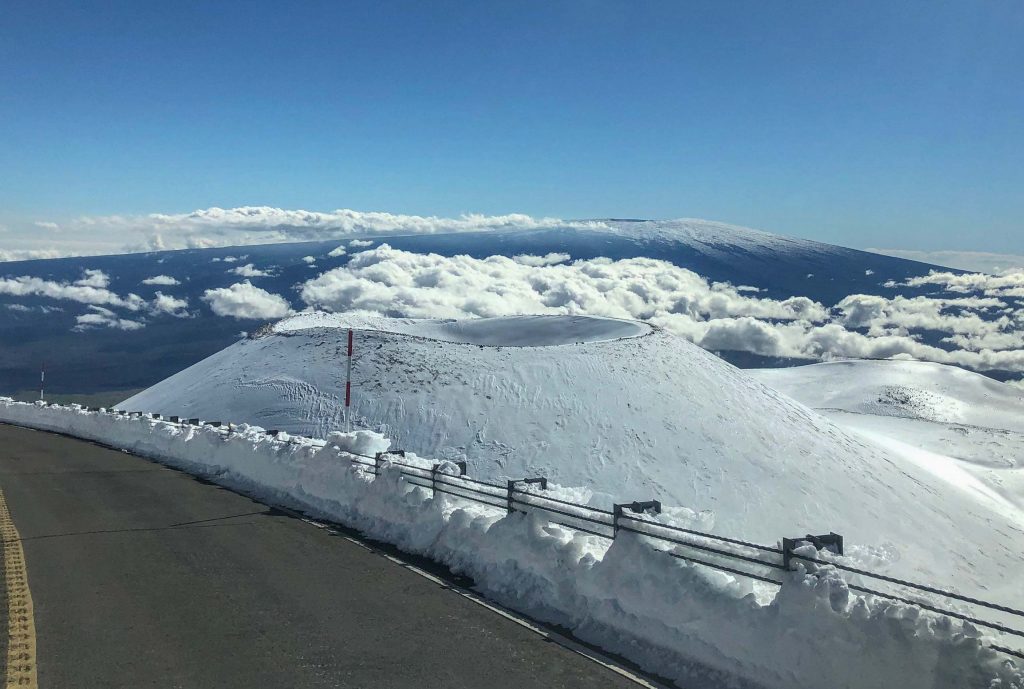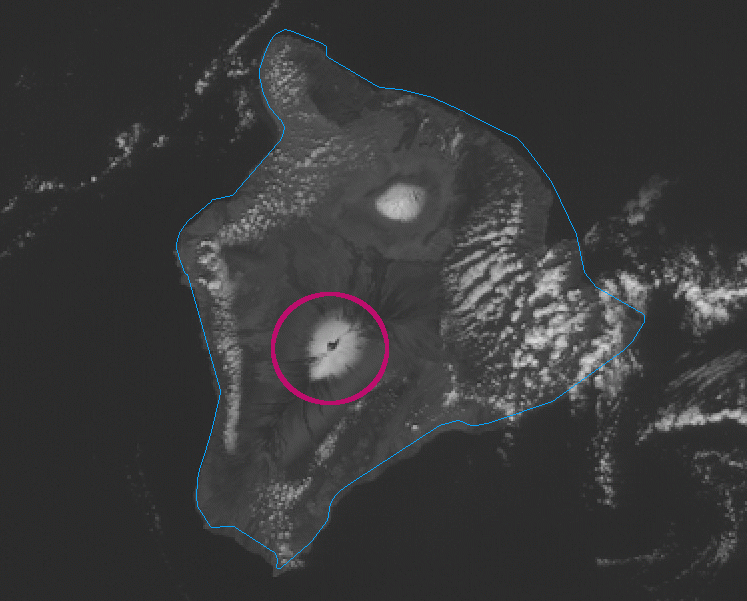A White Christmas for the Big Island at the mountain summits
We know the holidays are often green and bright for much of Hawaiʻi — the sun to shine by day and all the stars at night, as Bing Crosby might say. But, yes, Virginia, even the brightest Hawaiian Christmas Day can include snow blanketing the tallest summits in the islands.
So if you’re dreaming of a white Christmas in the land where palm trees sway, look no farther than the Big Island.
A check of webcams atop Maunakea early Friday afternoon showed snow still covering the summit following a major winter storm associated with the Kona low that swept through the state at the beginning of the week.
The University of Hawaiʻi at Hilo Center for Maunakea Stewardship on Friday morning reopened the road to the summit after crews spent much of the week clearing thick ice and heavy snow from the roadway.
Some photos also showed snow continuing to cover parts of Mauna Loa, only weeks after lava stopped flowing down the volcano’s northeastern flank during its first eruption in 38 years.
“Most people say you need 1 inch or more of snow on the ground for it to be considered a ‘White Christmas’,” said John Bravender, warning coordination meteorologist at the National Weather Service in Honolulu.
Snow removal crews worked from dawn til dusk since Tuesday to clear the snow-clogged Maunakea Access Road. Photos courtesy of the University of Hawaiʻi at Hilo Center for Maunakea Stewardship.
While forecasts don’t show any additional precipitation forecast this weekend at the Maunakea summit, it was only about 36 degrees at the summit early Friday afternoon, keeping the area pretty frigid. Temperatures look to continue to trend in the mid-30s during the weekend.
So unofficially, it looks likely that Hawaiʻi will have a white Christmas this year. But the official verdict isn’t as clear.

The National Oceanic and Atmospheric Administration defines a white Christmas, whether it’s in Hawaiʻi or not, as having at least 1 inch of snow on the ground on Dec. 25 at an official weather observation station, according to Howard Diamond, climate science program manager at the agency’s Air Resources Laboratory.
Based on that definition, the probabilities of a white Christmas on the Big Island at the two highest elevation official stations are zero.
Those weather stations, however, are not at the island’s tallest summits. They are only at about the 4,000-foot level in Hawaiʻi Volcanoes National Park and at the 9,256-foot level on Maunakea at Hale Pōhaku.
“For Hawaiʻi, our official climate stations are at lower elevations,” Bravender said, adding that even the snowfall reports the National Weather Service gets from Maunakea are “unofficial” since they’re all after the fact. “No one is at the summit to incrementally measure snow while it is falling and the wind also makes it nearly impossible to get an accurate non-drifting measurement.”
So while the official probability of a white Christmas is zero based on NOAA’s definition and the locations of its highest Big Island climate stations, Diamond said that does not preclude the fact that there very well could be snow on Christmas Day at the peaks of Mauna Loa, Maunakea and even Haleakalā on Maui.
It snows every year in Hawaiʻi at the summits of the state’s three tallest mountains, but almost never below 9,000 feet, according to Ken Rubin, a professor at the University of Hawaiʻi at Mānoa School of Ocean and Earth Science and Technology. It can snow at lower elevations, too, it just takes precipitation and cold enough temperatures, usually at 32 degrees or below.
Bravender said it snowed in February 2019 at the 6,200-foot level on Maui at Polipoli Spring State Recreation Area, and the Western Regional Climate Center mentions snow down to 7,000 feet.
Bruce Omori, on the evening of Jan. 26, 2021, posted a public video on Facebook showing snow flying on Daniel K. Inouye Highway, or Saddle Road, on the Big Island. The highway reaches a maximum elevation of 6,632 feet. The video showed no accumulation though.
“This is crazy! It’s freaking cold, too. Awesome! Awesome! Only in Hawaiʻi,” he can be heard saying in the video, which has 970 reactions, nearly 300 comments and 75,000 views.
Rubin said there also have been “freak” cold storms a few times in the past century that have brought snowstorms down as low as 3,000 to 4,000 feet. That snow melted very quickly. The islands enjoy warm tropical weather pretty much the entire year, so whenever snow falls, and no matter where, it doesn’t last long. Even at the three tallest summits, snow rarely stays on the ground more than a few days.
That means snow is even more special in Hawaiʻi when it sticks around for awhile, and now that Maunakea Access Road is open again, rangers are anticipating an increase in summit traffic, which is typical after a heavy snowfall. It’s almost tradition that when there’s snow atop Maunakea, you go — and sometimes even truckloads of the wintry precipitation find their way down the mountain to a beach or someone’s front yard.
A public post Tuesday in a Facebook group was already asking if the access road was open so the poster could take their keiki up the mauna to get the snow experience. Paul Rabena in a public Facebook post of his own that day said he was thinking about 4-by-4’ing up Maunakea, filling the truck bed with snow and bringing it back down to Magic Sands Beach in Kona to start a snowball fight.
“Wow, that’s just genius, lol,” replied Pat Rabena.
“Wait for me cuz. I’m on my way,” added Gene Viernes.
“Do it,” Maggie De Sa egged them on.
“Pics or it didn’t happen!” replied Kelli Teichman.

Like this year, sometimes the snow coincides with Christmas, making it an even more special occasion.
“This guy gets the ‘Father of the Year’ award,” Rick Swing said in a public Facebook post on Christmas Day in 2017. “I talked to him at the stoplight. He drove 2 hrs to the top of Mauna Kea at 5 am and filled up his truck with snow, and drove it back to Pāhoa so that his kids could have a white Christmas and build a snowman together. Awesome move dad!”
Officials appreciate the desire to experience the Hawaiʻi snow, especially during the holidays. All they ask is that people stay safe and respectful while doing so. The public is reminded that emergency services could be two hours away because of Maunakea’s remote location. Cellphone coverage also is unreliable, and there is just one public emergency phone on the summit.
“We understand lots of kamaʻāina and visitors are looking forward to driving up to the mauna. However, we urge everyone to please adhere to all directions and precautions from our Maunakea rangers,” said Nahua Guilloz, director of stewardship at the Center for Maunakea Stewardship, in a press release. “Safety is of utmost importance to us and we need the public’s kōkua to help keep everyone free from harm.”












